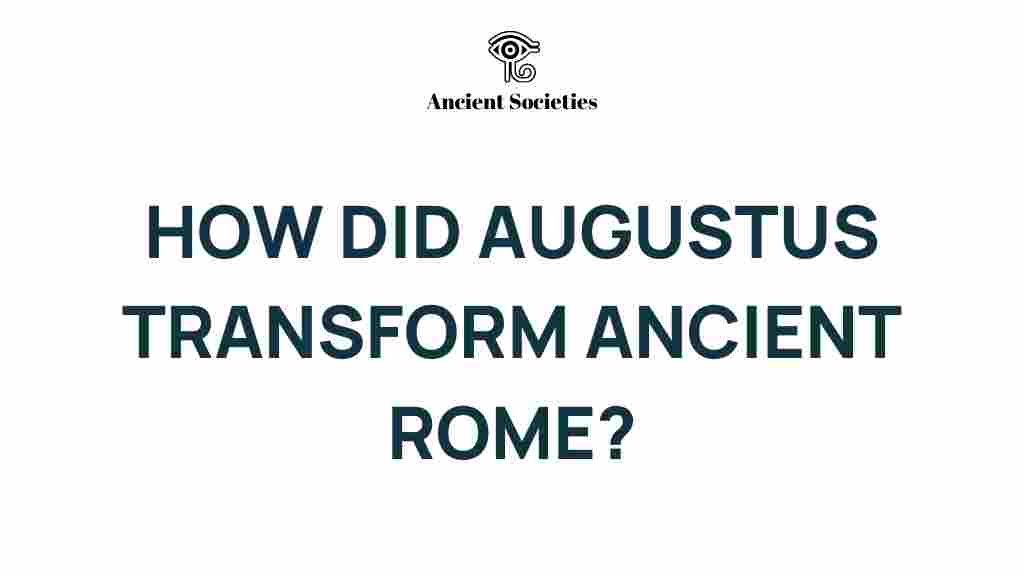Augustus: The Catalyst for Transformation in Ancient Rome
Augustus, born Gaius Octavius Thurinus, stands as one of the most pivotal figures in the annals of history. His reign marked a significant transformation in Ancient Rome, transitioning it from a republic plagued by civil wars to a powerful empire. This article explores how Augustus’s leadership, political acumen, and cultural initiatives laid the foundation for a new era in Roman history.
Understanding Augustus: The Man and His Times
To comprehend Augustus’s impact on Ancient Rome, it is essential to understand the historical context in which he emerged. Born in 63 BC, Augustus was the grandnephew of Julius Caesar. After Caesar’s assassination in 44 BC, a power vacuum ensued, leading to a series of civil wars. Augustus, initially part of the Second Triumvirate, gradually consolidated power, ultimately becoming the first Roman Emperor.
The Transformation of Ancient Rome Under Augustus
Augustus’s reign from 27 BC to AD 14 was marked by dramatic transformations in governance, culture, and society that solidified the foundations of the Roman Empire.
1. Political Reforms: Establishing the Principate
One of Augustus’s most significant contributions was the establishment of the Principate, a new form of governance that maintained the facade of republicanism while centralizing authority.
- Restoration of Order: Augustus prioritized stability after years of turmoil. He initiated reforms that curtailed the power of the Senate and elevated the role of the Emperor.
- Legal Reforms: He enacted laws that improved the administration of justice, enhancing the legal system for Roman citizens.
2. Military Innovations: Expansion and Security
Augustus understood that military strength was crucial for both the protection and expansion of the empire. His military strategies played a vital role in transforming Ancient Rome.
- Professional Army: Augustus established a standing army, which was a drastic shift from the previous reliance on conscription. This professional army was loyal to the emperor.
- Border Security: He fortified the empire’s borders and conducted successful military campaigns, extending Rome’s territories into parts of Europe and the East.
3. Cultural Renaissance: The Golden Age
Augustus’s reign also ushered in a cultural transformation that led to what is often referred to as the Golden Age of Latin literature. He patronized poets, artists, and scholars, fostering an environment of creativity and innovation.
- Literature: Prominent figures like Virgil and Horace flourished under Augustus’s patronage, producing works that celebrated Roman values and the empire’s glory.
- Architecture: Augustus famously claimed to have found Rome a city of bricks and left it a city of marble. His extensive building projects, including temples and monuments, reflected his vision for a grand Rome.
Augustus and the Politics of Power
Augustus’s approach to governance was characterized by a blend of subtlety and strength. He understood the importance of public perception and utilized propaganda to enhance his authority.
1. The Use of Propaganda
Augustus masterfully used art and literature as tools of propaganda. He commissioned works that depicted him as a benevolent leader and a divine figure.
- Coinage: Augustus placed his image on coins, ensuring that his visage was widely circulated throughout the empire.
- Public Speeches: He delivered speeches that emphasized his achievements and the peace he brought to the empire, known as the Pax Romana.
2. Building Alliances
Augustus understood the value of alliances in solidifying his power. He strategically formed relationships with influential families and military leaders.
- Marriage Alliances: Through marriages, he linked his family with other prominent Roman families, strengthening his political base.
- Support from the Military: By ensuring that the military was well-compensated and loyal, he secured a crucial pillar of support for his regime.
Steps to Understanding Augustus’s Legacy
To fully grasp the extent of Augustus’s transformation of Ancient Rome, consider the following steps:
- Study the Historical Context: Examine the political chaos of the late Republic and how Augustus emerged as a stabilizing force.
- Analyze Political Reforms: Look at how Augustus’s establishment of the Principate changed the structure of Roman governance.
- Explore Military Strategies: Investigate how Augustus’s military reforms contributed to the security and expansion of the empire.
- Appreciate Cultural Contributions: Review the works of poets and artists who thrived during Augustus’s reign, noting their impact on Roman culture.
- Evaluate Propaganda Techniques: Consider how Augustus manipulated public perception through various forms of media.
Troubleshooting Common Misunderstandings
While studying Augustus, it is essential to address some common misconceptions:
- Myth of Absolute Power: Many assume Augustus ruled as a dictator. In reality, he maintained a delicate balance between power and republican ideals.
- Underestimation of Influence: Some overlook the profound influence of Augustus’s reforms on subsequent emperors and the long-term stability of the empire.
Conclusion: The Enduring Legacy of Augustus
Augustus’s transformation of Ancient Rome was not just a moment in history; it was a catalyst for the development of an empire that would endure for centuries. His leadership style, political reforms, military innovations, and cultural patronage created a legacy that shaped governance, politics, and culture in ways that resonate even today.
Understanding Augustus is crucial for anyone interested in the history of governance and the evolution of power structures. His life and reign illustrate how effective leadership can steer a nation through turmoil into a golden age of prosperity and peace.
For more insights into ancient history, check out our comprehensive guide on the Roman Empire. Additionally, for further reading on Augustus’s impact on culture, visit this external resource.
This article is in the category History and created by AncientSocieties Team
